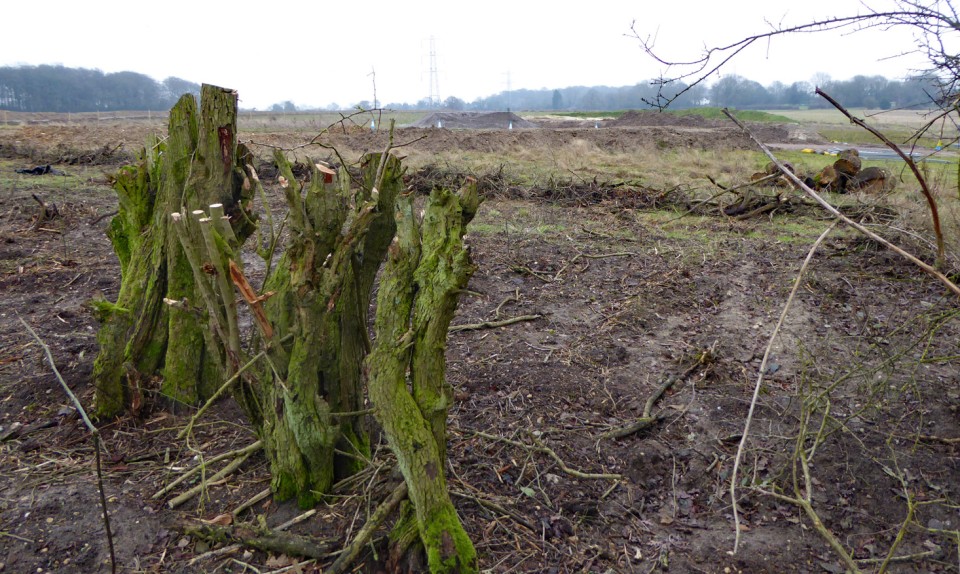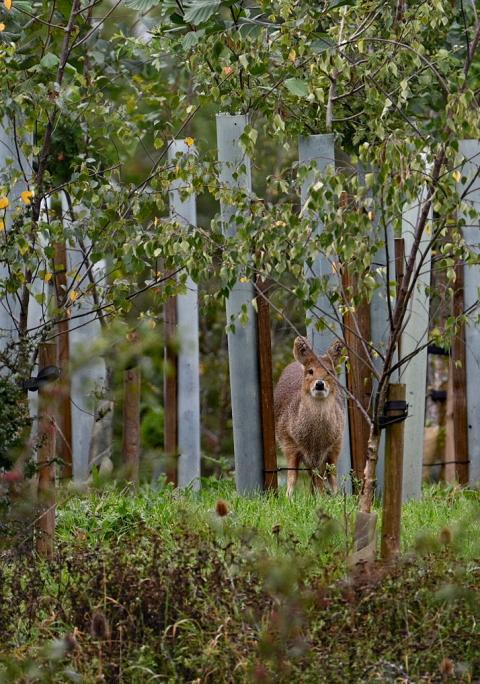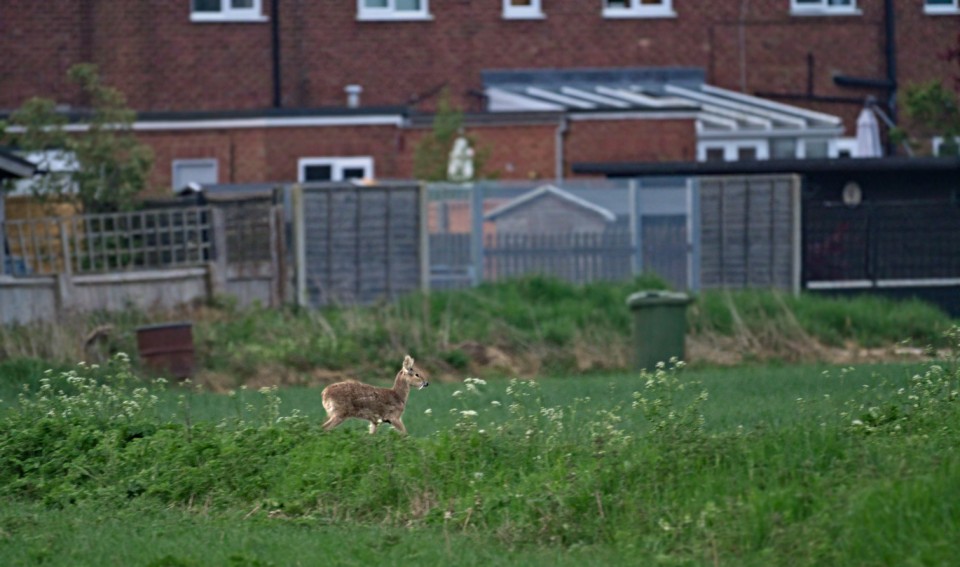Water Deer Interaction with Humans - Habitat Loss

As early as 1908, writing in Shooting in China, Thomas Jernigan told of the habitat fragmentation already impacting water deer populations:
"For nearly twenty years after the Taiping rebellion the low lying lands in the province, especially known as the Kashing Plain, and the endless reed beds to be met with to the west of the Tai Hu, were the favored haunts of the river deer, but now an energetic cultivation and an acutely active reclamation of the marsh lands have driven them to the countless asylums which the river Yangtze affords, and whence the market supplies are derived. … The pheasant, woodcock and deer cannot live and prosper long when they have to contend with the railways and the breech loader."
In their 2015 review of the species for the IUCN Red List of Threatened Species, Richard Harris and Will Duckworth note that habitat loss through reclamation for agriculture and urban development was still a major threat to water deer in eastern China. Areas of appropriate habitat that were formerly widespread north of the Yangtze River delta have been lost and the remaining areas fragmented, leaving remaining subpopulations isolated and vulnerable, while less than 1% of the species' preferred habitat falls within China's 449 national nature reserves. Likewise, in her 2020 Semi-aquatic Mammals: Ecology and biology, Glynnis Hood described the loss of wetlands and riparian areas as central to the dramatic declines of many semi-aquatic mammal populations in China, despite anthropogenic wetlands such as rice paddy plantations being able to support some species, including water deer.

In their Chinese paper to Wetland Science in 2009, Min Chen and colleagues at the East China Normal University discuss some of the habitat destruction that has taken place in the Chinese wetlands over the past few decades, noting how suitable deer habitat in the east has been lost to land reclamation for human development, particularly the area to the east of the Western Europe-Western China (WE-WC) highway, a transcontinental expressway from the Yellow to the Baltic seas, which has shrunk considerably since the 1950s. "In particular, a large number of coastal beach and pond development and occupation has led to the segregation and fragmentation of the deer's habitat …", the authors write, while annual reed harvesting not only removes cover, but also increases the level of human disturbance in the habitat. Overall, they note a sharp decline in both abundance and distribution of water deer in the Yancheng and Dafeng reserves in Jiangsu Province since the 1990s. In their paper, the scientists call for more habitat to be protected, and for fragmented habitat to be linked up.
More recently, in their Chinese 2012 paper to the Journal of Zhejiang A&F University, Mi-lan Liu and colleagues report on the impact of the development of high-speed traffic networks on the potential habitat of water deer in suburban areas in the eastern suburbs of Nanjing City, in eastern China's Yangtze River Delta. Their analysis suggested that, compared with 2006, the potential habitat for water deer in 2011 had decreased, fragmenting the habitat and creating what the authors refer to as "a bird cage effect". They recommended that ecological corridors be established between Mount Zijin, Qinglong, and Tangshan to mitigate the negative impact of increased road infrastructure on the wildlife habitats. They also noted that the distance to roads and settlements were the two human disturbance factors determining how suitable potential habitat was.

Along similar lines, Julong Huang and his team at Wuhan University observed that while afforestation in their study area around Nanjing between 1996 and 2016 had resulted in an increase in potentially suitable habitat for larger mammals, such as water deer, most of the vital corridors connecting the habitat up in 1996 were subsequently cut off by motorways that connected the city core to the subcentres. In their paper to Science of the Total Environment in 2018, they argue that a "polycentric approach" should be adopted, integrating ecological network analysis into the planning process to try and ensure habitat connectivity during the early phase of developments.
In central South Korea during 2016, Jihyang Jung and colleagues used Habitat Suitability Indexing to predict the distribution of water deer in the Chungnam Province. They found that only 13.5% of the province could be regarded as high-quality habitat for water deer, this being mainly forest areas as they've been well managed within the parks of the region, owing largely to human influence/disturbance. In 2019, Jiyoung Choi and Sangdon Lee, at the Ewha Womans University in Seoul, used a habitat mapping technique to calculate a "Cumulative Habitat Unit" (CHU) value, basically a score of how suitable/valuable a habitat is to a species with higher values being more suitable, before and after the installation of South Korea's Hongcheon-Inje Express Highway in Gangwon Province, which opened in 2011 following a four-year construction project. The researchers calculated that the CHU was 1211 prior to the construction, falling to only 299 after construction. Of particular importance, however, was the observation that the installation of eco-corridors, stretches of vegetated land 40 metres (130 ft.) wide by 200-700 m (650-2,300 ft.) long that crossed the road, was a good mitigating factor, resulting in the CHU increasing by as much as 363 points to 662 depending on the location of the corridor.
As we have seen (see: Vehicle Collisions) vehicle collision with water deer is an increasing problem in South Korea, and an increase in road building coupled with inefficient barriers and a lack of corridors only seem to exacerbate the issue. Furthermore, between 2001 and 2004, in South Korea's largest mountain wildland, Mt. Chirisan National Park, designated in 1967, Shin-Jae Rhim and Woo-Shin Lee found that where the habitat had been fragmented by development and roads, water deer were strongly associated with the edges of forest areas. Presumably, they were attracted by greater availability of shrubs and young trees in this edge zone. This potentially makes them more likely to be involved in accidents. Similarly, Taek-Woo Nam and colleagues, in their 2020 paper to the Journal of Korean Environmental Research & Technology, observed that water deer living on Daebudo Island in South Korea's Yellow Sea were particularly drawn to the cultivated lands near the roads, but "due to the bare lands and roads, it is expected that their habitats would be fragmented and damaged, which would have a direct and indirect effect in maintaining the population".

We have seen both in the UK and South Korea that water deer can and do adapt to habitat change. In Korea they can be found close to and sometimes even in cities, while in Britain they have readily taken to farmland many kilometres from coastal marshes and some conservations schemes may promote this. The practice of set-aside in England, for example, where land owners either leave field margins to grow wild or sow wildflower mixes in an effort to support nationally declining populations of birds and insects, seems to be beneficial to water deer, which are regularly found resting and feeding in these margins. Similarly, the Bedford & Milton Keynes Waterway Park, part of the Forest of Martson Vale expansion project that aims to create a 25 km (16 mile) stretch of woodland connecting Bedford to Milton Keynes in Bedfordshire is likely to benefit the water deer and potentially aid their spread within the county. Of course, in many cases disturbance by humans using such areas can deter and displace deer, but we do know that water deer can adapt to at least moderate disturbance in Britain and this is already evident in the wild in parts of Bedfordshire. In South Korea during 2017, for example, Seung-Hun Son and his co-workers found that even intensive thinning of a Japanese larch plantation didn't have a significant impact on its use by water deer. This means that it's difficult to predict how water deer will respond to disturbance or change, so it's important to build in mitigation at the design phase of developments that cut into the species' habitat.